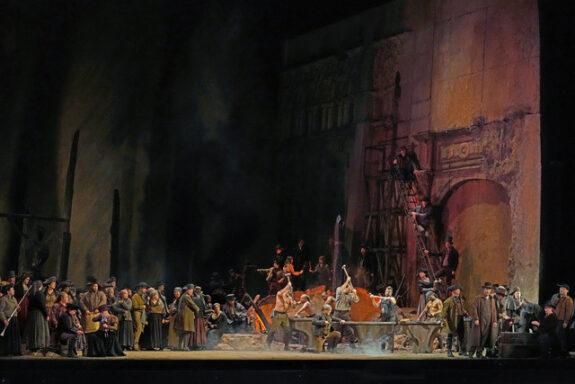 United States Verdi, Il trovatore: Soloists, Chorus and Orchestra of the Metropolitan Opera / Daniele Callegari (conductor). Metropolitan Opera, New York, 22.11.2024. (RP)
United States Verdi, Il trovatore: Soloists, Chorus and Orchestra of the Metropolitan Opera / Daniele Callegari (conductor). Metropolitan Opera, New York, 22.11.2024. (RP)

Production:
Director – Sir David McVicar
Revival director – Paula Williams
Sets – Charles Edwards
Costumes – Brigitte Reiffenstuel
Lighting – Jennifer Tipton
Choreographer – Leah Hausman
Chorus director – Tilman Michael
Cast:
Ferrando – Ryan Speedo Green
Ines – Briana Hunter
Leonora – Angela Meade
Count di Luna – Igor Golovatenko
Manrico – Arturo Chacón-Cruz
Azucena – Olesya Petrova
Old Gypsy – Ned Hanlon
Messenger – Jeremy Little
Ruiz – Daniel O’Hearn
Off-stage drama can really shake things up, and so it did with the current run of Il trovatore at the Metropolitan Opera. Midway through the 17 November performance, both Angela Meade as Leonora and Michale Fabiano as Manrico bowed out due to illness. Soprano Leah Hawkins got plaudits for coming to the rescue, but Mexican-American tenor Arturo Chacón-Cruz seized the day and may have won gold.
Fast forward five days and lightning struck again, with Fabiano still out sick and Chacón-Cruz on stage as Manrico. He sang splendidly, the audience embraced him and a new Met star is in the making. Never mind that he has appeared in the world’s major opera houses regularly for some time now.
Chacón-Cruz may not have cut a heroic, action-figure-like Manrico, but he is a compelling troubadour nonetheless. His tenor is cut from lyrical cloth rather than from metal, but that works too, and he sailed through ‘Di quella pira’, topping it off with a ringing high C. It is not a backhanded compliment to note that some of his finest vocal efforts came from offstage. It was mighty fine singing, displaying a far richer and fuller voice than expected, which augurs even better for his future success at the Met.
Physicality is not Meade’s strong suit, but through face and voice she creates a compelling Leonora. Her soprano is the real thing, no doubt about that: her sizeable, voluptuous voice fills out Verdi’s expansive musical lines with ease. If Meade’s high notes in this performance did not exactly shimmer and float effortlessly, that can be chalked up to the lingering effects of whatever had sidelined her. At full volume, however, her top notes were something to be reckoned with.
Igor Golovatenko had a fine night as Count di Luna. With charisma to burn, he torched the stage with his hatred for Manrico and desire for Leonora. When expressing Luna’s love for Leonora in ‘Il balen’, Golovatenko had the ease, range, power and beauty of a true Verdi baritone.
Appearance-wise, Olesya Petrova’s Azucena may look a bit worse for wear, but her gypsy exudes a certain youthful vigor and physical glamour. They are not the usual calling cards of an Azucena. Petrova was indefatigable as she shot off vocal fireworks with her powerhouse of a voice: her ‘Stride la vampa’ was riveting and impressive for the clean articulation of the aria’s many notes and trills. She sang of the gypsy’s longing to return to the mountains in the final scene in the softest tones imaginable to devastating effect.
Caruso famously quipped that four great voices was all it took to make a great performance of Il trovatore, but a fifth does not hurt. As Ferrando, Ryan Speedo Green was that deluxe extra wheel, commanding the stage with his stature and powerful voice.
Daniele Callegari provided all the support necessary to keep this performance together. His eyes were always focused on Chacón-Cruz to ensure no lapse in coordination whatsoever. Much of the impact of Petrova’s singing came from the conductor’s ability to get the orchestra to produce a mere shimmer of sound.

The men of the Met Chorus impressed, especially in the Anvil Chorus which was accompanied by some musclebound blacksmiths hammering away on their anvils. In the convent scene, the women of the chorus produced a light, silvery sound which added an atmosphere of mystery and reverence: further evidence that the Met found the right person in its new chorus director, Tilman Michael.
David McVicar’s production was first staged at the Met in 2009 and plays it safe and straight. The action is updated to the nineteenth century during the Spanish War of Independence over which the spirit of Goya looms large. The set is basic, with two walls intersecting to create different scenes. It is a model of efficiency that rotates to reveal castle walls, the courtyard of a cloister and the Gypsy camp. In the background, the charred bodies hang from crosses. The staging may not be overly imaginative, but it never goes off the rails.
Rick Perdian
